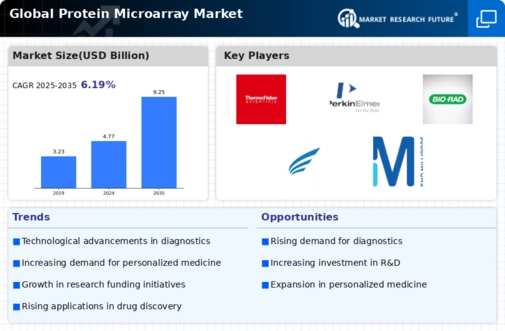-
Definition
-
Scope of the Study
- Research
- Assumptions
- Limitations
-
Introduction
-
Primary Research
-
Secondary research
-
Market Size Estimation
-
Drivers
-
Restrains
-
Opportunities
-
Challenges
-
Macroeconomic
-
Technology Trends & Assessment
-
Porter’s Five Forces Analysis
- Bargaining Power
- Bargaining Power of Buyers
- Threat of New Entrants
- Threat of Substitutes
- Intensity of Rivalry
-
Value Chain
-
Investment Feasibility Analysis
-
Pricing Analysis
-
Global Protein Microarray Market, by Type
-
Introduction
-
Protein
- Market Estimates & Forecast, 2020 – 2027
-
chips
-
Lab-on-chips
- Market Estimates & Forecast, 2020 – 2027
-
(microfluidics)
-
Integrated systems
- Market Estimates & Forecast, 2020 –
-
Arrayers
- Market Estimates & Forecast, 2020 –
-
Microarray systems
- Market Estimates & Forecast, 2020
-
– 2027
-
Chapter 7. Global Protein Microarray Market, by Application
-
Introduction
-
Diagnostics
- Market Estimates & Forecast,
-
Proteomics
- Market Estimates & Forecast, 2023-2032
-
Protein functional analysis
- Market Estimates & Forecast, 2023-2032
-
Antibody characterization
-
Chapter 8. Global Protein Microarray Market,
-
by Product
-
Introduction
-
Protein microarray instruments
-
8.2.1
-
Market Estimates & Forecast, 2023-2032
-
Protein microarray reagents
- Market Estimates & Forecast, 2023-2032
-
Protein microarray services
- Market Estimates & Forecast, 2023-2032
-
Chapter 9. Global Protein
-
Microarray Market, by Technology
-
Introduction
-
Analytical microarrays
- Market Estimates & Forecast, 2023-2032
-
Functional protein microarrays
- Market Estimates & Forecast, 2023-2032
-
Reverse phase protein
- Market Estimates & Forecast, 2023-2032
-
microarray
-
Chapter 10.
-
Global Protein Microarray Market, by End User
-
Introduction
-
Hospitals
- Market Estimates & Forecast, 2023-2032
-
Clinics
-
10.3.1
-
Market Estimates & Forecast, 2023-2032
-
Diagnostic Centers
-
10.4.1
-
Market Estimates & Forecast, 2023-2032
-
Academic Institutes
-
10.5.1
-
Market Estimates & Forecast, 2023-2032
-
Research centers
-
10.4.1
-
Market Estimates & Forecast, 2023-2032
-
Others
- Market Estimates
-
& Forecast, 2023-2032
-
Chapter. 11 Global Protein Microarray Market, by
-
Region
-
Introduction
-
Americas
- North America
- South America
-
11.2.1.1
-
U.S.
-
Europe
-
11.3.1
-
Western Europe
-
11.3.2
-
Eastern Europe
-
11.4.3
-
India
-
Pacific
-
Chapter
-
Germany
-
France
-
Italy
-
Spain
-
U.K
-
Rest of Western Europe
-
Asia Pacific
- Japan
- China
- Australia
- Republic of Korea
- Rest of Asia
-
The Middle East & Africa
- United Arab Emirates
- Saudi Arabia
- Rest of the Middle East & Africa
-
Company Landscape
-
Introduction
-
Market Share Analysis
- Key Developments
-
12.3
-
Key Development & Strategies
-
Chapter 13 Company
-
Profiles
-
GE Healthcare
- Company Overview
- Product
- Financials
- SWOT Analysis
-
Overview
-
Thermo Fisher
- Company Overview
- Product Overview
- Key Developments
- SWOT Analysis
- Company Overview
- Product Overview
- Financial Overview
- Key Development
- SWOT Analysis
-
Scientific
-
13.2.3
-
Financial Overview
-
13.3
-
Bio-Rad Laboratories Inc.
-
Agilent Technologies
- Company Overview
- Product/Business
- Financial Overview
- Key Development
-
Segment Overview
-
13.4.5
-
SWOT Analysis
-
PerkinElmer Inc.
- Company Overview
- Financial overview
- Key Developments
-
13.5.2
-
Product Overview
-
Cepheid Inc.
- Company Overview
- Product Overview
- Financial Overview
- Key Developments
-
Fluidigm Corporation
- Overview
- Product Overview
- Financials
- SWOT Analysis
-
13.7.4
-
Key Developments
-
F. Hoffmann-La Roche Ltd
- Company Overview
- Product/Business Segment Overview
- Key Development
- SWOT Analysis
- Company Overview
- Product Overview
- Key Developments
-
13.8.3
-
Financial Overview
-
13.9
-
Illumina Inc.
-
13.9.3
-
Financial overview
-
Others
-
Chapter 14
-
MRFR Conclusion
-
Key Findings
- From CEO’s View Point
- Unmet Needs of the Market
-
Key Companies to Watch
-
Prediction
-
of Pharmaceutical industry
-
Chapter 15 Appendix
-
LIST OF TABLES
-
Protein Microarray Industry Synopsis, 2023-2032
-
Protein
-
Microarray Market Estimates and Forecast, 2023-2032, (USD Million)
-
Table 3
-
Protein Microarray Market by Region, 2023-2032, (USD Million)
-
Protein
-
Microarray Market by Type, 2023-2032, (USD Million)
-
Protein Microarray
-
Market by Application, 2023-2032, (USD Million)
-
Protein Microarray
-
Market by Product, 2023-2032, (USD Million)
-
Protein Microarray Market
-
by Technology, 2023-2032, (USD Million)
-
Protein Microarray Market by
-
End Users, 2023-2032, (USD Million)
-
North America Protein Microarray
-
Market by Type, 2023-2032, (USD Million)
-
North America Protein Microarray
-
Market by Application, 2023-2032, (USD Million)
-
North America Protein
-
Microarray Market by Product, 2023-2032, (USD Million)
-
North America
-
Protein Microarray Market by Technology, 2023-2032, (USD Million)
-
Table 13
-
North America Protein Microarray Market by End User, 2023-2032, (USD Million)
-
US Protein Microarray Market by Type, 2023-2032, (USD Million)
-
Table
-
US Protein Microarray Market by Application, 2023-2032, (USD Million)
-
Table
-
US Protein Microarray Market by Product, 2023-2032, (USD Million)
-
Table
-
US Protein Microarray Market by Technology, 2023-2032, (USD Million)
-
Table
-
US Protein Microarray Market by End User, 2023-2032, (USD Million)
-
Table
-
Canada Protein Microarray Market by Type, 2023-2032, (USD Million)
-
Table
-
Canada Protein Microarray Market by Application, 2023-2032, (USD Million)
-
Canada Protein Microarray Market by Product, 2023-2032, (USD Million)
-
Canada Protein Microarray Market by Technology, 2023-2032, (USD Million)
-
Canada Protein Microarray Market by End User, 2023-2032, (USD Million)
-
South America Protein Microarray Market by Type, 2023-2032, (USD Million)
-
South America Protein Microarray Market by Application, 2023-2032, (USD
-
Million)
-
South America Protein Microarray Market by Product, 2023-2032,
-
(USD Million)
-
South America Protein Microarray Market by Technology,
-
South America Protein Microarray Market by
-
End User, 2023-2032, (USD Million)
-
Europe Protein Microarray Market
-
by Type, 2023-2032, (USD Million)
-
Europe Protein Microarray Market
-
by Application, 2023-2032, (USD Million)
-
Europe Protein Microarray
-
Market by Product, 2023-2032, (USD Million)
-
Europe Protein Microarray
-
Market by Technology, 2023-2032, (USD Million)
-
Europe Protein Microarray
-
Market by End User, 2023-2032, (USD Million)
-
Western Europe Protein
-
Microarray Market by Type, 2023-2032, (USD Million)
-
Western Europe
-
Protein Microarray Market by Application, 2023-2032, (USD Million)
-
Table 36
-
Western Europe Protein Microarray Market by Product, 2023-2032, (USD Million)
-
Western Europe Protein Microarray Market by Technology, 2023-2032, (USD
-
Million)
-
Western Europe Protein Microarray Market by End User, 2023-2032,
-
(USD Million)
-
Eastern Europe Protein Microarray Market by Type, 2023-2032,
-
(USD Million)
-
Eastern Europe Protein Microarray Market by Application,
-
Eastern Europe Protein Microarray Market
-
by Product, 2023-2032, (USD Million)
-
Eastern Europe Protein Microarray
-
Market by Technology, 2023-2032, (USD Million)
-
Eastern Europe Protein
-
Microarray Market by End User, 2023-2032, (USD Million)
-
Asia Pacific
-
Protein Microarray Market by Type, 2023-2032, (USD Million)
-
Asia Pacific
-
Protein Microarray Market by Application, 2023-2032, (USD Million)
-
Table 46
-
Asia Pacific Protein Microarray Market by Product, 2023-2032, (USD Million)
-
Table
-
Asia Pacific Protein Microarray Market by Technology, 2023-2032, (USD Million)
-
Asia Pacific Protein Microarray Market by End User, 2023-2032, (USD Million)
-
The Middle East & Africa Protein Microarray Market by Type, 2023-2032,
-
(USD Million)
-
The Middle East & Africa Protein Microarray Market
-
by Application, 2023-2032, (USD Million)
-
The Middle East & Africa
-
Protein Microarray Market by Product, 2023-2032, (USD Million)
-
The
-
Middle East & Africa Protein Microarray Market by Technology, 2023-2032, (USD
-
Million)
-
The Middle East & Africa Protein Microarray Market by
-
End User, 2023-2032, (USD Million)
-
LIST OF FIGURES
-
Figure
-
Research Process
-
Segmentation for Protein Microarray Market
-
Figure
-
Segmentation Market Dynamics for Protein Microarray Market
-
Global
-
Protein Microarray Market Share, by Type 2020
-
Global Protein Microarray
-
Market Share, by Application 2020
-
Global Protein Microarray Market
-
Share, by Product, 2020
-
Global Protein Microarray Market Share, by
-
Technology, 2020
-
Global Protein Microarray Market Share, by End Users,
-
Global Protein Microarray Market Share, by Region, 2020
-
Figure
-
North America Protein Microarray Market Share, by Country, 2020
-
Figure 12
-
Europe Protein Microarray Market Share, by Country, 2020
-
Asia Pacific
-
Protein Microarray Market Share, by Country, 2020
-
The Middle East
-
& Africa Protein Microarray Market Share, by Country, 2020
-
Global
-
Protein Microarray Market: Company Share Analysis, 2020 (%)
-
GE Healthcare:
-
Key Financials
-
GE Healthcare: Segmental Revenue
-
GE
-
Healthcare: Geographical Revenue
-
Thermo Fisher Scientific: Key Financials
-
Thermo Fisher Scientific: Segmental Revenue
-
Thermo Fisher
-
Scientific: Geographical Revenue
-
Bio-Rad Laboratories Inc.: Key Financials
-
Bio-Rad Laboratories Inc.: Segmental Revenue
-
Bio-Rad
-
Laboratories Inc.: Geographical Revenue
-
Agilent Technologies: Key
-
Financials
-
Agilent Technologies: Segmental Revenue
-
Figure 27
-
Agilent Technologies: Geographical Revenue
-
PerkinElmer Inc.: Key
-
Financials
-
PerkinElmer Inc.: Segmental Revenue
-
PerkinElmer
-
Inc.: Geographical Revenue
-
Cepheid Inc.: Key Financials
-
Figure
-
Cepheid Inc.: Segmental Revenue
-
Cepheid Inc.: Geographical Revenue
-
Fluidigm Corporation: Key Financials
-
Fluidigm Corporation:
-
Segmental Revenue
-
Fluidigm Corporation: Geographical Revenue
-
Figure
-
F. Hoffmann-La Roche Ltd: Key Financials
-
F. Hoffmann-La Roche
-
Ltd: Segmental Revenue
-
F. Hoffmann-La Roche Ltd: Geographical Revenue
-
Illumina Inc.: Key Financials
-
Illumina Inc.: Segmental
-
Revenue
-
Illumina Inc.: Geographical Revenue










Leave a Comment